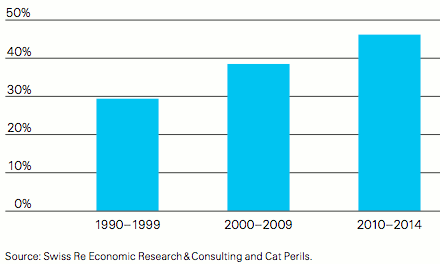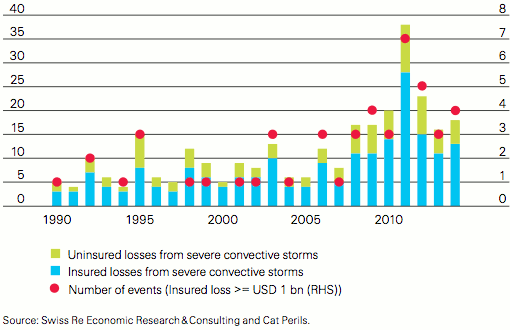Global total economic and insured losses from severe convective storms is on the rise as the event’s sub-perils, which includes hail storms, flooding, severe thunderstorms and tornadoes, caused increasing losses in 2014, according to reinsurer Swiss Re.
The reinsurance firm’s latest Sigma report, ‘Natural catastrophes and man-made disasters in 2014: convective and winter storms generate most losses,’ provides a comprehensive view of natural and man-made catastrophes during 2014, revealing an upward loss trend from severe convective storms since 1990.
“The global total and insured losses from severe convective storms grew at average annual rates of 7.7% and 9%, respectively.
“In contrast, total and insured losses from all natural catastrophe events in the same period grew by 6.4% and 6.6% on average each year, respectively,” notes the report.
Similarly, the percentage of all-weather related losses attributed to the severe convective storm peril has increased steadily over the last 25 years, from an average 29% in the 1990s to over 40% during the last 5 years, highlighted in the graph below.

Severe convective storm-related insured losses as % of all-weather event insured losses - Source: Swiss Re
The rise in annual economic and insured losses from the convective storm family is mostly caused by tornado events in the U.S. and hail and flooding losses across Europe, states the report.
Cold, dry air from Canada meets hot, moist air from the desert southwest and the Gulf of Mexico, ensuring the states faces more tornadoes every year than anywhere else on earth.
However, in 2015 data provided by the National Weather Service Storm Prediction Center reveals that so far, in 2015, the number of tornadoes reported remains significantly below the previous ten-year average of 192 for this time of year. It’s worth noting that there was a deadly tornado event just yesterday in Moore, Oklahoma. This is early in the year for a tornado death, which shows that despite a slow season the peril can still have tragic consequences.

Daily tornado count and annual running trend - Source: NOAA SPC
But a gradual spike in total and insured losses from convective storms isn’t necessarily attributed to a rise in hail, severe thunderstorms, flooding or tornado events, as societal and economic development can be a key driver of rising losses.
Growing asset values, global population levels continuing upwards, increased urbanisation, and in particular greater migration to coastal regions and natural hazard prone areas are all strong drivers for rising annual loss figures from severe thunderstorms, and other members of the severe convective storm group.
This point is echoed in the Sigma report, which claims that since 2008, in the U.S., annual insured losses from severe convective storms have surpassed $10 billion, even in 2014 which was the least active U.S. tornado season since the early 1990s.

US total and insured losses from severe convective storms in USD billions, and number of events leading to insured losses in excess of USD 1 billion - Source: Swiss Re
Artemis also discussed this point recently when we covered AIR Worldwide and the UNISDR’s vision and scope for building the world’s resilience to natural disasters and reducing related economic losses.
While tornadoes dominate losses in the U.S., intense hail, flooding and windstorms create the most problems in Europe, and flooding often causes widespread devastation across Asia, highlighting the potential severity and inherent complexity of the severe convective storm peril.
Multiple sub-perils can occur at any one time, in any one region, which in turn creates problems with the modelling of convective storms, explains the study.
“Because of the wide variety of approaches and assumptions used, the models rarely compare well with one another. These challenges and difficulties are further amplified with short, incomplete, or non-existent historical records,” states the report.
While the insurance, reinsurance, insurance-linked securities (ILS), catastrophe bond and wider risk transfer sector offers protection against severe convective storms, and its sub-perils, “the increasing losses from severe convective storms are a growing challenge for society and insurers alike,” warns the report.
The harsh reality, cautions Swiss Re, “is that modelling severe convective storm risk is inherently difficult.”
Concluding that firms need to develop a broader, more detailed historical record of severe convective storm events and losses; “Only then will severe convective storm risk assessment be significantly improved.”
 View all of our Artemis Live video interviews and subscribe to our podcast.
View all of our Artemis Live video interviews and subscribe to our podcast.
All of our Artemis Live insurance-linked securities (ILS), catastrophe bonds and reinsurance video content and video interviews can be accessed online.
Our Artemis Live podcast can be subscribed to using the typical podcast services providers, including Apple, Google, Spotify and more.































